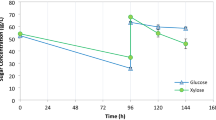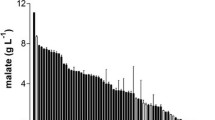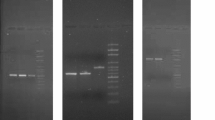Abstract
Findings show 21 fungal isolates belonging to eight genera recovered from Egyptian soils that have the potential to attack l-methionine under submerged conditions. Aspergillus flavipes had the most methioninolytic activity, giving the highest yield of l-methioninase (10.78 U/mg protein), rate of methionine uptake (93.0%), and growth rate (5.0 g/l), followed by Scopulariopsis brevicaulis and A. carneus. The maximum l-methioninase productivity (11.60 U/mg protein) by A. flavipes was observed using l-methionine (0.8%) as an enzyme-inductive agent and glucose (1%) as a co-dissimilated carbon source. A significant reduction in l-methioninase biosynthesis by A. flavipes was detected using carbon-free medium, suggesting the lack of ability to use l-methionine as a carbon and nitrogen source. Potassium dihydrogen phosphate (0.25%), the best source of phosphorus, favors enzyme biosynthesis and enhances the level of methionine uptake by A. flavipes. The maximum l-methioninase productivity (12.58 U/mg protein) and substrate uptake (95.6%) were measured at an initial pH of 7.0.





Similar content being viewed by others
References
Abarca ML, Accensi F, Cano J, Cabanes FJ (2004) Taxonomy and significance of black aspergilli. Antonie Van Leewenhoek 86:33–49
Amarita F, Yvon M, Nardi M et al (2004) Identification and functional analysis of the gene encoding methionine-γ-lyase in Brevibacterium linens. Appl Environ Microbiol 70:7348–7354
Arfi K, Landaud S, Bonnarme P (2006) Evidence for distinct l-methioninne catabolic pathways in the Yeast Geotrichum candidum and the bacterium Brevibacterium linens. Appl Environ Microbiol. 72:2155–2161
Bergstorm M, Ericson K, Hagenfeldt L (1987) PET study of methionine accumlation in glioma and normal brain tissue: competition with branched chain aminho acids. J Comput Assist Tomogr 11:208–213
Bilgrami KS, Verma RN (1981) Physiology of fungi, 2nd edn. Vikas Publishing, PVT, Ltd Indian, pp 23–27
Bondar DC, Beckerich JM, Bonnarme P (2005) Involvement of a branched-chain aminotransferase in production of volatile sulfur compounds. Yarrwialipolytica 71:4585–4591
Bonnarme P, Lapadatescu C, Yvon M, Spinnler HE (2001) l-methionine degradation potentialties of cheese-ripening microorganisms. J Dairy Res 68:663–674
Booth C (1971) The genus Fusarium. Commenwealth Mycological Institute, Kew
Breillout F, Antoine E, Poupon MF (1990) Methionine dependency of malignant tumors: a possible approach for therapy. J Natl Cancer Inst 82:1628–1632
Caddick MX, Peters D, Platt A (1994) Nitrogen regulation in fungi. Antoine van Leeuwenhoek 65:169–177
Challenger F, Charlton PT (1947) Studies on biological methylation. 10. The fission of the mono and disulfide links by molds. J Chem Soc (Lond) 424–429
Cuer A, Dauphin G, Kergomard A et al (1979) Flavour properties of some sulphur compounds isolated from cheeses. Lebensmittelwiss Technol 12:258–261
Domsch KH, Gams W, Anderson T (1980) Compendium of soil fungi. Academic Press
dos Passos JB, Vanhalewyn M, Brandao RL (1992) Glucose-induced activation of plasma membrane H+-ATPase in mutants of the yeast Saccharomyces cerevisiae affected in cAMP metabolism, cAMP-dependent protein phosphorylation, and the initiation of glycolysis. Biochemica et Biophysica Acta 1136:57–67
Ellis MB (1971) Dematiaceous Hyphomycetes. Commonwealth Mycological Institute, Kew
El Sayed ASA (2008) l-glutaminase production by Trichoderma koningii under solid state fermentation. Ind J Microbiol (in press)
Halpern BC, Clark BR, Hardy DN et al (1974) The effect of replacement of methionine by hemocystine on survival of malignant and normal adult mammalian cells in culture. Proc Natl Acad Sci USA 71:1133–1136
Hawkins DS, Park JR, Thomson BG et al (2004) Asparaginase pharmacokinetics after intensive polyethylene glycol-conjugated l-asparaginase therapy for children with relapsed acute lymphoblastic leukemia. Clin Cancer Res 10:5335–5341
Hess WC, Sullivan MX (1943) The cysteins, cystine and methionine content of proteins. J Biol Chem 151:635–642
Hori H, Takabayashi K, Orvis L et al (1996) Gene cloning and characterization of Pseudomonas putida l-methionine-α-deamino-γ-mercaptomethane-lyase. Cancer Res 56:2116–2122
Ito S, Nakamura T, Eguchi Y (1976) Purification and characterization of methioninase from P. putida. J Biohem 79:1263–1272
Jennings DH (1995) The physiology of fungal nutrition, 1st edn. Cambridge University Press, Cambridge
Johnson LF, Curl EA, Bond JH, Fribourg HA (1959) Methods for studying soil microflora—plant disease relationships. Burgess Publishing Co., MN
Kawashima K, Takeshima H, Higashi Y et al (1991) High efficacy of monomethoxypolyethylene glycol: conjugated l-asparaginase (PEG2-ASP) in two patients with hematological malignancies. Leukemia Res 15:525–530
Kokkinakis DM, Hoffman RM, Frankel EP (2001) Synergy between methionine stress and chemotheray in the treatment of brain tumor xenografts in athymic mice. Cancer Res 61:4017–4023
Kokkinakis DM, Schold SC Jr, Hori H, Nobori T (1997) Effect of long-term depletion of plasma methionine on the growth and survival of human brain xenografts in athymic mice. Nutr Cancer 29:195–204
Lockwood BC, Coombs GH (1999) Purification and characterization of methionine γ-lyase from Trichomonas vaginalis. Biochem J 279:675–682
Lowry OH, Rosebrough NJ, Farr AL et al (1951) Protein measurements with the Folin phenol reagent. J Biol Chem 193:265–275
Lund F (1995) Differeniating Penicillium species by detection of indole metabolites using a filter paper mehod. Lett Appl Microbiol 20:228–231
Merricks DL, Salsbury RL (1974) Involvement of vitamin B6 in the dethiomethylation of methionine by rumen microorganisms. Appl Microbiol 28:106–111
Mitchell AP, Magasanik B (1984) Regulation of glutamate-repressible gene products by the GLN3 function in Saccharomyces cerevisiae. Mol Cell Biol 4:2758–2766
Monk BC, Niimi M, Shepherd MG (1993) The Candida albicans plasma membrane and H+-ATPase during yeast growth and germ tube formation. J Bacteriol 175:5566–5574
Nakayama T, Esaki N, Lee EJ et al (1984) Agric Biol Chem 48:2367–2369
Ohigashi K, Tsunetoshi A, Ichihara K (1951) The role of pyridoxal in methylmercaptan formation partial purification and resolution of methioninase. Med J Osaka Univ 2:111–117
Pall ML (1971) Amino acid transport in Neurospora crassa: IV. Properties and regulation of a methionine transport system. Biochem Biophys Acta 233:201–214
Pitt JI (1979) The Genus Penicillium and Its Teleomorphic States Eupenicillium and Talaromyces. Academic Press, London
Raper KB, Fennell DI (1965) The genus Aspergillus. The Williams and Wilkins Company, Baltimore
Rifai MA (1969) A revision of the genus Trichoderma. Commonwealth Mycological Institute, Kew
Ruiz-Herrera J, Starkey R (1970) Dissimilation of methionine by Achromobacter starkeyi. J Bacteriol 104:1286–1293
Ruiz-Herrera J, Starkey RL (1969) Dissimilation of methionine by fungi. J Bacteriol 94:544–551
Ruiz-Herrera J, Starkey RL (1969) Dissimilation of methionine by a demethiolase of Aspergillus species. J Bacteriol 99:764–770
Samson RA, Noonim P, Meijer M et al (2007) Diagnostic tools to identify black aspergilli. Stud Mycol 59:129–145
Snedecor GW, Cochran WG (1982) Statistical Methods, 6th ed. edn. Blackwell Science Ltd, London, p 147
Stahl WH, Ncqu B, Mandels GR et al (1949) Studies on the microbiological degradation of wool. 1. Sulfur metabolism. Arch Biochem 20:422–432
Tan Y, Sun X, Xu M et al (1998) Polyethylene glycol conjugation of recombinant methioninase for cancer therapy protein. Expr Purif 12:45–52
Tan Y, Xu M, Guo H et al (1996) Anticancer efficacy of methioninase in vivo. Anticancer Res 16:3931–3936
Tan Y, Xu M, Tan X et al (1997) Overexpression and large-scale production of recombinant l-methionine-α-deamine-δ-mercaptomethane-lyase for novel anticancer therapy. Protein Expr Purif 9:233–245
Tanaka H, Esaki N, Yamamoto T, Sodo K (1976) Purification and properties of methioninase from Pseudomonas ovalis. FEBS Lett 66:307–311
Tsugo T, Matsuko M (1962) The formation of volatile sulfur compounds during the ripening of the semisoft white mould cheese. In: Proceedings of the 16th international dairy congress, Copenhagen, Denmark, vol B, pp 385–394
Thompson JF, Morrison GR (1951) Determination of organic nitrogen: control of variables in the use of Nessler’s reagent. Anal Chem 23:1153–1157
Wiesendanger S, Nisman B (1953) La l-methionine demercapto desaminase: un novel enzyme a’ pyridoxal phosphate. Compt Rend 237:764–765
Author information
Authors and Affiliations
Corresponding author
Rights and permissions
About this article
Cite this article
Khalaf, S.A., El-Sayed , A.S.A. l-Methioninase Production by Filamentous Fungi: I-Screening and Optimization Under Submerged Conditions. Curr Microbiol 58, 219–226 (2009). https://doi.org/10.1007/s00284-008-9311-9
Received:
Revised:
Accepted:
Published:
Issue Date:
DOI: https://doi.org/10.1007/s00284-008-9311-9




